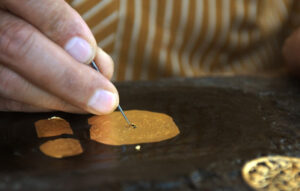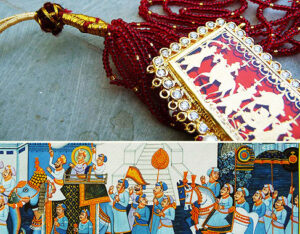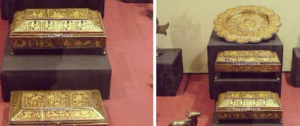 Thewa Art is a centuries-old masterful technique that involves intricately crafting gold filigree on a molten glass foundation with vibrant colours. Nature and mythology serve as inspiration for the intricate patterns in this fine gold latticework. An analogy that comes to mind is a gold painting set against a glass surface. One of the 64 skills that Lord Shiva is said to have mastered in the Ramayana is Thawai art, which many people now consider to be synonymous with Thewa art.
Thewa Art is a centuries-old masterful technique that involves intricately crafting gold filigree on a molten glass foundation with vibrant colours. Nature and mythology serve as inspiration for the intricate patterns in this fine gold latticework. An analogy that comes to mind is a gold painting set against a glass surface. One of the 64 skills that Lord Shiva is said to have mastered in the Ramayana is Thawai art, which many people now consider to be synonymous with Thewa art.
Combining the terms ‘therna’ with ‘wada’ results in ‘Thewa’. Therna is the process of using an iron tool called an aeran to hammer and shape gold into a paper-thin thickness. A silver rim, or wada, is fashioned to enclose the precious metal and keep it safe. In the vernacular of Rajasthan, the word ‘thewa’ also means ‘setting,’ and it describes the technique of attaching 23-karat gold onto multicoloured glass.
 Thewa artefacts are always made of pure gold that has been refined by heat. The gold sheets are shaped and flattened with aeran before being laid on raal (a lac-resin mix). Using a pen-like instrument called a tankla, a design is embossed on the sheets in a technique known as kantaarna. The “Thewa Ki Patti” is a sheet of 23-karat gold metal decorated with motifs inspired by mythology, religion, everyday life, and hunting. Maharana Pratap and his legendary mount, Chetak, are shown with great honour in these regal portraits. Popular figures from mythology, such as Srinathji, Radha-Krishna, Lord Ram, Hanuman, Mahadev, and the mother goddesses, are among the many included in this vast collection. Lattice preparation clarifies the visuals. To transfer the imprint of the gold plate from the raal to the glass, it must be heated to remove the plate and then immersed in acid. Glass is often made in the three primary hues of red, blue, and green. The last stages of making this art include secret methods and mixes. These last procedures are what give the glass its shine and longevity. Beads and other precious and semiprecious stones are used to decorate the finished products.
Thewa artefacts are always made of pure gold that has been refined by heat. The gold sheets are shaped and flattened with aeran before being laid on raal (a lac-resin mix). Using a pen-like instrument called a tankla, a design is embossed on the sheets in a technique known as kantaarna. The “Thewa Ki Patti” is a sheet of 23-karat gold metal decorated with motifs inspired by mythology, religion, everyday life, and hunting. Maharana Pratap and his legendary mount, Chetak, are shown with great honour in these regal portraits. Popular figures from mythology, such as Srinathji, Radha-Krishna, Lord Ram, Hanuman, Mahadev, and the mother goddesses, are among the many included in this vast collection. Lattice preparation clarifies the visuals. To transfer the imprint of the gold plate from the raal to the glass, it must be heated to remove the plate and then immersed in acid. Glass is often made in the three primary hues of red, blue, and green. The last stages of making this art include secret methods and mixes. These last procedures are what give the glass its shine and longevity. Beads and other precious and semiprecious stones are used to decorate the finished products.
 The Raj Sonis, or goldsmiths of the Nathulal Soni family, are the only practitioners of the 400-year-old inbred art form. Pratapgarh, a city in southern Rajasthan founded by Maharawat Pratap Singh between 1689 and 1699, is synonymous with this style of art. A goldsmith named Nathu Lal Sonewal created this form of goldwork in 1707. In 1775, Nathu Lal Soni’s work grabbed the eye of Maharawat Sawant Singh, who awarded him the title of Raj Soni (Royal goldsmith) and 300 bighas of land as jagir for his efforts. Since 1966, the Ministry of Textiles of the Government of India has regularly recognised the Raj Soni family with several national awards. A commemorative postage stamp honouring the artwork was issued by the Government of India on November 5, 2002. The artwork has gained enormous international recognition and is on show in the Victoria & Albert Museum and the Metropolitan Museum of Art. A few pieces, which date back 250 years, are said to be in Queen Elizabeth’s collection.
The Raj Sonis, or goldsmiths of the Nathulal Soni family, are the only practitioners of the 400-year-old inbred art form. Pratapgarh, a city in southern Rajasthan founded by Maharawat Pratap Singh between 1689 and 1699, is synonymous with this style of art. A goldsmith named Nathu Lal Sonewal created this form of goldwork in 1707. In 1775, Nathu Lal Soni’s work grabbed the eye of Maharawat Sawant Singh, who awarded him the title of Raj Soni (Royal goldsmith) and 300 bighas of land as jagir for his efforts. Since 1966, the Ministry of Textiles of the Government of India has regularly recognised the Raj Soni family with several national awards. A commemorative postage stamp honouring the artwork was issued by the Government of India on November 5, 2002. The artwork has gained enormous international recognition and is on show in the Victoria & Albert Museum and the Metropolitan Museum of Art. A few pieces, which date back 250 years, are said to be in Queen Elizabeth’s collection.
Thewa artwork was first used to decorate chests and boxes that were presented as gifts to the royal family. Frames, mirrors, cufflinks, brooches, trays, plates, and jewellery worn by both sexes today are all products of the skilled hands of these artisans.
For fear of diluting the expertise with marriage into other families, daughters are restrained from learning this art form and the knowledge of the craft is instead passed onto the sons, although now even daughters-in-law are marking their spots. Boys are as young as eleven when they begin their training. In addition to mastering the techniques of his craft, a thewa artist must also be an expert miniature artist to produce high-quality works.
 Due to the ever-increasing cost of gold, this kind of artwork is becoming more popular among those who care both about aesthetics and affordability. Even though a small quantity of gold is actually utilised, the finished product looks and feels quite luxurious. Thewa Art stands as a testament to the timeless fusion of craftsmanship, heritage, and innovation. Although unauthentic and fake pieces present the art form with tough competition, it has managed to flourish over the years due to the love and support of its customers who range from commoners to royalty. The rich tapestry of Thewa art, inspired by mythology, religion, and daily life, is a treasure trove of cultural narratives. This art form’s enduring legacy, preserved through generations and evolving with time, showcases the enduring allure of the art.
Due to the ever-increasing cost of gold, this kind of artwork is becoming more popular among those who care both about aesthetics and affordability. Even though a small quantity of gold is actually utilised, the finished product looks and feels quite luxurious. Thewa Art stands as a testament to the timeless fusion of craftsmanship, heritage, and innovation. Although unauthentic and fake pieces present the art form with tough competition, it has managed to flourish over the years due to the love and support of its customers who range from commoners to royalty. The rich tapestry of Thewa art, inspired by mythology, religion, and daily life, is a treasure trove of cultural narratives. This art form’s enduring legacy, preserved through generations and evolving with time, showcases the enduring allure of the art.

